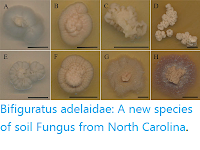Endophytic Actinomycete Fungi colonise the internal plant tissues and usually have a beneficial effect to the host plant by promoting growth and protecting the plant from biotic and abiotic stresses without any damage or morphological changes to the plant. Isolation and identification of novel genus and species of Endophytic Actinomycetes is an attractive propostition for microbiologists since these organisms are potential sources for plant growth-promoting Bacteria and compounds. Substances isolated from Endophytic Actinomycetes have been shown to produce compounds which enhance plant growth, chelate iron and other elements, reduce plant stress ethylene, and solubilise of inorganic phosphate.
In a paper published in the journal Microorganisms on 25 March 2020, Huyền Thị Thanh Phạm of the Department of Genetics and Omics Center for Agriculture at Kasetsart University, Wipawadee Suwannapan, also of the Department of Genetics at Kasetsart University, Wilaiwan Koomsiri, again of the Department of Genetics and Omics Center for Agriculture at Kasetsart University, Yuki Inahashi of the Kitasato Institute for Life Sciences at Kitasato University, Akira Také of the Department of Microbiology at the Kitasato University School of Medicine, Atsuko Matsumoto, also of the Kitasato Institute for Life Sciences at Kitasato University, and Arinthip Thamchaipenet, once again of the Department of Genetics and Omics Center for Agriculture at Kasetsart University, describe a new species of Endophytic Actinomycete Fungi isolated from the roots of the Black Wattle Tree, Acacia mangium, growing in the grounds of Kasetsart University in Bangkok.
The new species is placed in the genus Fodinicola, which contains only one previously described species, Fodinicola feengrottensis, which was isolated from acidic metal-containing rocks of a medieval alum slate mine in Germany, and is given the specific name acaciae, which derives from 'Acacia', the generic name of the host plant. It is a gram-stain-positive, aerobic, non-motile, catalase-positive, oxidase-negative actinomycete that produces branched substrate mycelium and abundant aerial mycelium. Aerial hyphae break up into irregular rod-like elements. Colonies are wrinkled, beige to orange in colour. Growth occurs between 14 and 42 °C, good growth at 28 °C, and no growth below 14 °C or above 42 °C. Good growth occurs at pH 7.0 and pH 8.0, but no growth occurs at pH 3 nor pH 12. NaCl (salt) tolerance is up to 6%.
Scanning electron micrograph of fragmentation of aerial hyphae of Fodinicola acaciae on agar at 28 °C after 21 days. Scale bar is 2 μm. Pham et al. (2020).
See also...
Follow Sciency Thoughts on Facebook.







